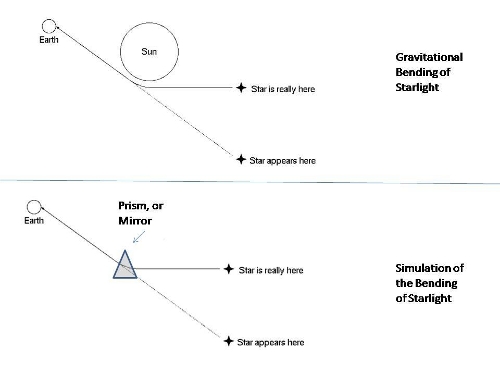by Richard Obousy
Physicist Richard Obousy has long been fascinated with the Casimir force, dark energy, and the stability of higher dimensions. His dissertation at Baylor University, in fact, focused on the possibility that dark energy could be an artifact of Casimir energy in extra dimensions. Now project leader of Project Icarus, Obousy here takes a look at a recent paper by Igor Smolyaninov (University of Maryland) that explores the Alcubierre ‘warp drive’ concept from the standpoint of material parameters. Can warp drive be modeled in the laboratory, and under what constraints? Finding the answer may yield new information about this exotic concept. As Smolyaninov says in his paper, “We will find out what kind of metamaterial geometry is needed to emulate a laboratory model of the warp drive, so that we can build more understanding of the physics involved.”

Fermat’s principle dictates that light rays follow the shortest optical paths in media. Effectively they are geodesics, and Einstein’s General Theory of Relativity (GR) has developed the theoretical tools for studying fields in curved geometries.
General Relativity also has the capability to predict the path a light ray would travel under unusual gravitational conditions, for example, black-holes, big bangs, wormholes and warp drives. One of the underlying principles behind GR is that matter affects space in such a way that space becomes curved. GR contains all the necessary mathematical machinery to model this.
Until recently, there has been no way to recreate such exotic gravitational conditions in a lab. The best we can do is simulate them on a computer. However, with the advent of metamaterials, we now have much improved capability to manipulate electromagnetic (EM) radiation and to physically simulate the remarkable phenomena predicted in GR.
This has been done recently in the context of the Alcubierre Warp Drive.
One aspect of Igor Smolyaninov’s recent work that I would like to emphasize is that it is a simulation of the path a light ray would travel – not a duplication of the phenomenon. See, for example, the figure below. GR predicts that an object as massive as the sun has the capacity to bend space in such a way that the path that a light ray takes becomes curved when it enters the influence of the stars gravity. A star, therefore, can appear to be somewhere different from a star-chart’s prediction due to the bending of its path by the sun.
Now, in the absence of the sun, the light ray could be coerced to follow a similar path with the simple inclusion of a device such as a prism, or a mirror, which refracts/reflects the light, forcing it to take an identical path to the one it would have taken in the presence of the sun.
Image: The bending of starlight due to a powerful gravitational field, compared with the ‘simulated’ bending by inserting a prism, or mirror in the appropriate position. Above illustrates a prism, but a mirror, angled correctly, could achieve the same effect. Credit: Richard Obousy.
Of course, the prism, or mirror, is not actually bending spacetime, it is merely mimicking the effect. Analogously, metamaterials provide experimentalists the ability to mimic, or simulate exotic light ray trajectories thanks to the remarkable property of metamaterials having a negative refraction (when examined macroscopically).
So, a black hole, warp drive or big bang is not actually being created -its effects, on light, are simply being simulated.
With regard to the paper ‘Metamaterial-based model of the Alcubierre warp drive’, Smolyaninov derives some of the features that a metamaterial would need in order to simulate the Alcubierre warp drive in the lab. Due to certain physical restrictions, only a simulation of sub-light velocities is possible, up to about 25% the speed of light. Of course, no propulsion actually occurs – just a simulation of the space in the immediate vicinity of a sublight warp drive.
Although Smolyaninov’s paper won’t directly assist us in getting to Alpha Centauri, it is certainly a welcome tool for physicists interested in exploring some of the properties of warp drives in the lab!
The paper is Smolyaninov, “Metamaterial-based model of the Alcubierre warp drive,” available as a preprint.




“One of the underlying principles behind GR is that matter effects space in such a way that space becomes curved. ”
English is not my first language but I think there’s a typo.
What I’d like to see, with all these purported FTL methods, is a way that they could be plausibly constructed. Sure, a traversable wormhole or an Alcubierre drive may be a valid solution for the Einstein field equations, but is there a way that such a metric could be achieved starting from (nearly) flat space?
TK writes:
Exactly so, TK, and thanks for the heads-up. I just fixed the typo (‘effects’ changed to ‘affects’).
From the late, great John A. Wheeler: “Space tells matter how to move. Matter tells space how to curve.” That probably should be “spacetime,” but I will leave the quote as it has come down to us.
Sorry, Richard Obousy’s article about Igor Smolyaninov’s paper “Metamaterial-based model of the Alcubierre warp drive” does not go deep enough for me, because of which I will try a more thorough assessment.
Smolyaninov, after having mentioned various properties of electromagnetic metamaterials and their usefulness with respect to the simulation of physical systems, introduces Alcubierre’s warp drive spacetime and it’s special metric — which is different from the metric of our real spacetime. The warp drive metric involves something like a stretching of spacetime.
Smolyaninov lists several reasons, implied by contemporary physics, why the warp drive does not work in our universe: “… warp drives appear to be prohibited by the laws of physics.”
Using the theory of warp drives, contemporary physics, and known properties of real ordinary, i.e. non-meta, materials, Smolyaninov concludes: “the warp drive model is impossible to make with ordinary materials.” Here the statements in the theory of warp drives have the logical state of preconditions, and some facts we know about ordinary materials contradict some of these preconditions.
Smolyaninov proceeds with properties of electromagnetic metamaterials from this reference: Metamaterials proposed as perfect magnetoelectrics, by Shuvaev, Engelbrecht, Wunderlich, Schneider, and Pimenov. According to the abstract: “Magnetoelectric susceptibility of a metamaterial built from split ring resonators have been investigated both experimentally and within an equivalent circuit model.” The magnetoelectric susceptibility is the ratio of magnetization to magnetizing force.
Based on what he presented so far, Smolyaninov concludes, that the metamaterial mentioned indeed makes it possible to construct an electromagnetic simulation model, which is close enough to a warp drive spacetime. The stated goal of his work is obtained.
In a last point, Smolyaninov gives an upper bound of “warp speed” — i.e. the speed of a “warp bubble” with respect to external spacetime — in such a simulation mode as 0.25c, and reports experiments conducted by someone else supporting the model’s feasibility.
Now on to a critical assessment.
A little bit strangely Smolyaninov says “warp drives appear to be prohibited by the laws of physics”. Well, “appear” as “give the impression of being”. This sounds like in reality something else could be true. Using Smolyaninov’s own sources, the contemporary law of physics imply, that warp drives *are* impossible — and using the word “appear” gives the case a touch of incorrectness.
By the way, on Wikipedia you read “Alcubierre proposed a method of stretching space [etc.]”. Well, he did *not* propose a procedure for accomplishing something in reality. He put up a theory, and merely a theory. Did someone else at least propose an experiment involving the creation of a real warp bubble? No.
Now we are able to build an electromagnetic simulation model for something which is impossible in reality, and Smolyaninov says “so that we can build more understanding of the physics involved.” Is there *physics* involved, or additionally something which is not … er … *really* physics? What can we hope to gain from this? It’s rather questionable, whether, based on the model, we could say a warp drive has or will have this and that property. A sound physical theory should be able to make predictions.
Is Smolyaninov’s paper or, better, the simulation model described a tool for physicists interested in exploring some of the properties of warp drives in the lab? Not really, but some may think so.
News about warp drive Simulator at next big future:
Updated paper – metamaterial warp drive simulator:
http://nextbigfuture.com/2011/08/updated-paper-httparxivorgftparxivpaper.html
It’s seems that the warp drive simulation in a “perfect” bi-anisotropic non-reciprocal magnetoelectric metamaterial should gradually accelerating beyond 1/4 c look like than it’s a good news , a least I hope so.
The Alcubierre Warp Drive: On the Matter of Matter
Brendan McMonigal, Geraint F. Lewis, Philip O’Byrne
(Submitted on 26 Feb 2012)
The Alcubierre warp drive allows a spaceship to travel at an arbitrarily large global velocity by deforming the spacetime in a bubble around the spaceship.
Little is known about the interactions between massive particles and the Alcubierre warp drive, or the effects of an accelerating or decelerating warp bubble.
We examine geodesics representative of the paths of null and massive particles with a range of initial velocities from -c to c interacting with an Alcubierre warp bubble travelling at a range of globally subluminal and superluminal velocities on both constant and variable velocity paths.
The key results for null particles match what would be expected of massive test particles as they approach +/- c. The increase in energy for massive and null particles is calculated in terms of v_s, the global ship velocity, and v_p, the initial velocity of the particle with respect to the rest frame of the origin/destination of the ship.
Particles with positive v_p obtain extremely high energy and velocity and become “time locked” for the duration of their time in the bubble, experiencing very little proper time between entering and eventually leaving the bubble.
When interacting with an accelerating bubble, any particles within the bubble at the time receive a velocity boost that increases or decreases the magnitude of their velocity if the particle is moving towards the front or rear of the bubble respectively.
If the bubble is decelerating, the opposite effect is observed. Thus Eulerian matter is unaffected by bubble accelerations/decelerations. The magnitude of the velocity boosts scales with the magnitude of the bubble acceleration/deceleration.
Subjects:
General Relativity and Quantum Cosmology (gr-qc); Cosmology and Extragalactic Astrophysics (astro-ph.CO); High Energy Astrophysical Phenomena (astro-ph.HE)
Cite as:
arXiv:1202.5708v1 [gr-qc]
Submission history
From: Brendan McMonigal [view email]
[v1] Sun, 26 Feb 2012 00:57:15 GMT (1531kb)
http://arxiv.org/abs/1202.5708